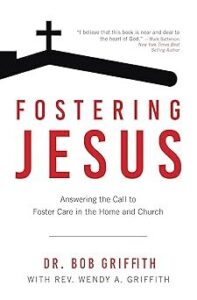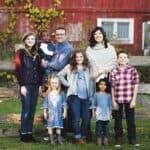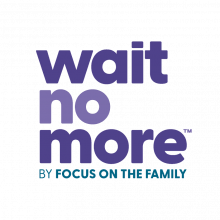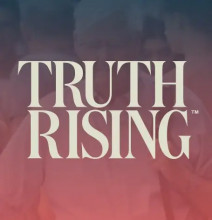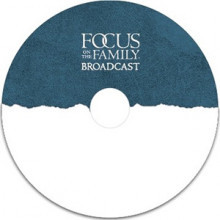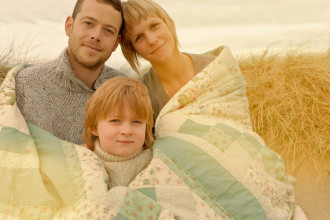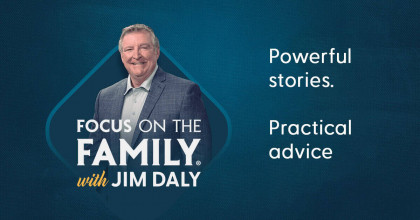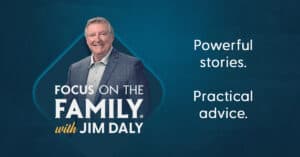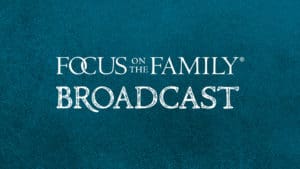John Fuller: In Scripture, God repeatedly reminds us that we can please Him by caring for widows and orphans. And today we’re gonna hear an inspiring story about helping vulnerable fatherless children through foster care. Welcome to Focus on the Family with Jim Daly. I’m John Fuller. And Jim, this is, uh, a real opportunity for us here.
Jim Daly: It is. You know, the estimates are there’s about 370,000 now in foster care. That’s down from when we started our efforts with Wait No More. Uh, I think the number was about 410,000. So it’s like the awareness is up. Churches are becoming more aware of the importance of engaging in foster care and foster adoption, and that’s a great thing. And I’m so proud of our team here at Focus on the Family. Dr. Sharen Ford is leading that effort and manages waking up every day and trying to, uh, make sure that people are aware of the need in foster care. There’s so many ways people can help, and we’re gonna talk about that today with our great guests that have done it. Um, and I’m looking forward to our discussion to help people think about ways to be the hands and feet of Jesus.
John: Mm-hmm.
Jim: And, you know, it’s so easy to go and listen to a great sermon and be inspired in your life and take care of your family. The next step is how do we take the Holy Spirit out into community? There’s nobody more vulnerable with greater chaos than the foster system.
John: Yeah.
Jim: They need Christians to bring God’s Shalom into that world.
John: Yeah. And Bob and Wendy Griffith are here. They have a lot of experience in this realm, uh, helping kids in foster care. It’s a big part of their ministry. They have six children, and Bob founded an organization called One Hope Together, which supports foster families. He’s currently a pastor in the Washington DC suburbs. Wendy is an ordained minister and public speaker. And together they’ve written a book called Fostering Jesus: Answering the Call to Foster Care in the Home and Church. And you can learn more about our guests and this book. We’ve got the details at focusonthefamily.com/broadcast.
Jim: Bob and Wendy, welcome to Focus on the Family. Good to have you.
Rev. Wendy Griffith: Thank you for having us.
Jim: First time.
Wendy: First time.
Dr. Bob Griffith: Yes. Thank you. This is great.
Jim: Are you nervous? I’m really nervous. (laughing) I’m kidding. You guys are both, uh, busy in ministry. You had two children, and then this idea about foster parenting pops up. How did that happen for you? Why did that catch your attention?
Wendy: Well, first we had, we had had trouble having children to begin with. And so it took us a couple years to have our first daughter. And then after a couple miscarriages, we were able to adopt our son privately through a private adoption. And then we had one more biological daughter, and we thought our family was complete. And we ended up on staff at a church in southeastern Wisconsin. And while we were there, we felt that there was a, there was a moment where we felt like God was saying, “It’s time to go outside the walls of the church.”
Jim: Mm-hmm.
Wendy: And so I remember saying to the Lord, “You know what is it that in this season that you want us to do?” And He said to me, “Well, what is the season that you’re in right now that you can never get back?” And that’s being a mom with kids at home. And so He said, “You can do one more.” And so we began that conversation and as Bob, as a community outreach pastor connected with the community and said, “What do you need?” There was a match.
Bob: Yeah. And it wasn’t as easy as maybe that story sounded for me. (laughs) So as the husband, uh, my-
Jim: Yeah. This is a typical story.
Bob: Yes. (laughs)
Wendy: Yes.
Bob: It’s relatively common. Uh, she was, uh, ahead of me in terms of compassion for the, these children.
Jim: Did you ever say, “Are you sure, Wendy, you heard God say that to you?” (laughs)
Bob: I never said that, um, (laughing) although she did ask me that question. She said, “You know, if you get to the point where God, uh, has spoken to you and you feel like God has led you into this, wo- would you agree?” And I said, “Well, yeah, of course. I mean, if, if I feel it is the Lord.” And that ultimately is what happened. But I, I do believe that part of my story is just one of resistance at first.
Jim: Hmm.
Bob: You know, I, I mean, just using logic, how are we gonna do this? We already had children. How is this gonna fit in? You know, financially, how do we do this? Do, do we have enough rooms in our home? You, you just process all that.
Jim: Yeah. Some practical issues.
Bob: So, so I… Yeah. So I was a little resistant at first, but we did have some families in our church that were faithfully living this out. And so we were, we were watching them be successful. Um, and that led to your question, which is, uh, the next step. And as part of my role in my church, I, at that time, I was a staff pastor, um, and I was charged with some of the, the, uh, moving the church forward in community service and outreach. So I just went and asked questions to the people that have a global perspective for our county. And we had, uh, similar to this setup, we had a roundtable. We had, uh, all the different heads of the different, you know, departments over the community. And I just asked them a simple question, which was it, you know, if you had a magic wand, you know, and you could just wave it and you could have our church do something, one thing that would make the biggest difference for our county, what would it be? And they all turned and looked at the head of foster care in our county. And, uh, and I remember, he looked at me and said, “Well, I guess that’s me.” And so from there, uh, we came home, we talked about it. We said, “You know, if this is truly, uh, one of the largest or the largest need in our community, uh, identified by them, then what can we do?” And we felt like it was a two-step answer. Number one was, what can we do as a couple? And then what can we do as a church? So that’s where it all began.
Jim: And then how, you know, from there, you’ve got two parallel stories going. One is your own household.
Wendy: Mm-hmm.
Jim: And then how do we help the church engage in this issue?
Bob: Yeah.
Jim: So I mean, as those things are developing, which one did you decide to tackle first, or did you do both at the same time?
Bob: Yeah.
Jim: And say, “Okay. Let’s, let’s get into foster.” Tell me how that unfolded for you.
Bob: Yeah.
Wendy: Well, I think what was really powerful too, that Bob said is it’s one thing for us to tell people that they should do it. (laughing) That foster care matters in the local church.
Jim: Yes.
Wendy: And to stand up there in, in the pulpit and say that, but it’s another thing for us to lead by example. And so I don’t think we realized how our example, uh, would impact our whole church and our community. And so that was something that was really powerful that we saw as, because that’s what got us involved in foster care-
Jim: Mm-hmm.
Wendy: …was watching other people do it.
Jim: Yeah.
Wendy: It normalized it. Everybody thinks they know what foster care is until you actually walk it out with someone. So as we got involved and we were dear friends with people who were already fostering, um, we realized that people watching us do it would be something that would multiply within the church.
Jim: So you got started in that direction first.
Wendy: Yeah.
Jim: So what were some of the, the things that happened within your own family? Describe how you got involved.
Bob: Yeah. Well, first of all, I, I didn’t know and couldn’t tell you where a foster child was in our community before we did this.
Wendy: Mm-hmm.
Bob: I mean, if you, if you asked me to take me right now and show me, I couldn’t do it.
Jim: Mm-hmm.
Bob: And, and what I didn’t realize is that we had many foster children actually coming to our church every Sunday. Um, it, and I didn’t even realize that. So once I realized that we truly had, uh, children that needed care in our community, um, that’s where we began caring for them, as, you know, as a family. And then in our church, we started to roll out just different things that we could do. And the momentum was there over time. Not at the beginning. At the beginning, you know, the very first thing we ever did was just do a little window in the church, you know, a 10-minute window just announcing that we had an information, um, table in the back. And we had a handful of people come, but, but we stayed consistent over the years, and over about five years that grew and grew and grew to the point where the, the county told me that we had 30% of all of the foster families in our entire county were attending our church.
Jim: Mm-hmm. Wow. And that just wasn’t obvious to you.
Bob: Right.
Jim: Yeah. That’s amazing. Let’s, let’s concentrate on your experience. So you get licensed, that’s a process.
Wendy: Yeah. They, they come to your house and we filled out the packet and they do the background checks. And I think one of the funny stories that we kind of experienced was when we were going through the interview together. I was much more like, “Hey, if God calls us, He’s gonna equip us.” And so there’s a box that you have to check. Are you open to potentially adopting a child you might foster? And I remember that I was like, “Oh, yeah. Check that box.” (laughs) Because if God says that we’re gonna do it-
Jim: (laughs) Bob was like, “Whoa, can we talk about this?”
Bob: I didn’t. I did not-
Wendy: And Bob was like… That’s exactly what he said. He was like, “Whoa. Whoa. Wait a second.”
Bob: Yeah.
Wendy: And, and I said to him, “Look,” I said, “If God tells you that this is what you’re supposed to do, would you do it?” And he said, “Well, yes.” I go, “Okay. Check the box.” (laughing)
Bob: Right.
Wendy: And so that’s what, that’s what we did. We, we did that.
Bob: So it truly was steps.
Jim: Yeah.
Bob: I mean, the first step was just filling out an application. That took a while.
Wendy: Yeah.
Bob: But, and then the next step was saying, “Okay, we’re gonna be in this for the goals of foster care in our city.”
Jim: Right.
Bob: And then the next thing was, um, the, the box about if it got to that point-
Wendy: Right.
Bob: … would you adopt?
Wendy: Which we were not in foster care to adopt at that point. Our family was complete. We just wanted to do our part.
Jim: Yeah.
Wendy: We didn’t know God had other ideas for our family.
Jim: Yeah. And that’s fine. I mean, people can start where they can start. Right? That have a heart for this.
Wendy: Yes.
Jim: But it’s so good to take that initial step. I saw some statistic in, in, maybe it was in the book, uh, 38% of church-going people have an interest in doing this. But only 1%-
Bob: Hmm.
Jim: … do take that next step.
Bob: That’s right.
Jim: I mean, that’s-
Wendy: Right.
Jim: … that’s the issue that, uh-
Bob: There’s a gap.
Jim: … we need to close that gap.
Bob: Mm-hmm.
Jim: And hopefully we can do that in part with the broadcast today, et cetera.
Bob: Good.
Jim: Let’s be realistic though. Let’s talk about that. Uh, Wendy, I so appreciate your perspective. Jean was the same way. (laughs) When we got on the, the broadcaster and I started talking about people engaging through our program Wait No More. Uh, I went home and she had heard the program. She said, “You know, you really, we need to do it if you’re gonna ask others to do it.”
Wendy: Yeah.
Jim: And I said, “No. I don’t have to. I was already a, a foster kid.
Wendy: Yeah.
Jim: I paid my, my dues.” (laughs).
Wendy: Yes.
Jim: And she looked at me that great-wife look like that doesn’t even pass the smell test. (laughs) So we got licensed and we did it as well. We probably fostered for 12 years or so.
Wendy: That’s amazing.
Bob: Wow.
Jim: And we’re still connected to two of the siblings that came into our home for like three years.
Wendy: Mm-hmm.
Jim: So that’s been a very… Now we’re like grandparents to them.
Wendy: Wow.
Jim: They live in a different state, but we’re still connected.
Bob: See? That’s amazing. Yeah.
Jim: But in that context, uh, that is typical of the, of the conversation.
Bob: Yeah.
Jim: The wife tends to be leaning into it. I think it’s a God-given nurturing-
Wendy: Mm-hmm.
Jim: … open-hearted kind of thing. And we’re the practical, “Well, wait a minute, how many bedrooms do we have?”
Bob: Right.
Wendy: Yes.
Jim: “And what’s the food budget gonna be?”
Wendy: Very much our story.
Jim: And Bah-bah-bah-bah, you know, and that’s everybody, I think.
Wendy: Yeah.
Jim: It’s pretty much Jean and I’s story too. But from that perspective, so describe, you get licensed, that’s a chore. You gotta just get through that. But then you get the phone call.
Wendy: Yes.
Bob: Mm-hmm.
Jim: That we did.
Bob: Mm-hmm.
Jim: And, uh, how’s that, how did that go for you guys?
Bob: Yeah.
Wendy: So we got a phone call and the first phone call, I, you know, they always give you the option whether or not it’s a, a good time, a good fit. And so the first phone call, we weren’t able to do anything with. The second phone call though was a seven-week-old baby girl. And she, they, you know, what’s so interesting is when you have a baby, there’s baby showers, people make you meals.
Jim: Mm-hmm.
Wendy: There’s all this preparation that goes into someone having a baby. But when you are a foster parent, you can have a child on your front step within 20 minutes with maybe some clothes, maybe no clothes. Um, and so it really is something that we realized pretty quick. There needs to be better support for foster parents because it was… It literally is, “Well, we’ll see you in 20 minutes.” And so we had this new little seven-week-old baby, and she didn’t come with any clothes or any- anything. And so, you know, you’re scrambling to find little girl outfits and you’re calling your friends and so-
Jim: Crib? (laughs)
Wendy: Yes. All of those things and-
Jim: Mm-hmm.
Wendy: … but it was so, what is so beautiful about being a part of a local church is that that’s something that people can rally around.
Jim: Mm-hmm.
Bob: Yeah.
Wendy: And there really is something in foster care that everyone can be a part. Not everybody can foster and bring a child into their home, but certainly people can bring meals, people can be praying for, people can do respite for foster families. Um, there’s so many ways to support.
Jim: Let, let me drill into the respite thing ’cause that was a word I, I wasn’t familiar with when we got started. It sounds like, you know, some kind of medical thing.
Wendy: Yeah.
Jim: But respite is just giving help to that family.
Wendy: Yes.
Jim: So you can do the laundry for them-
Wendy: Yes.
Jim: … you can do their grocery shopping.
Wendy: Yeah.
Jim: Um, you know, just something to wrap around that foster family to give them some relief from the long list of things they’ve got to do. I think we’ve looked at that. It’s something like if five families come alongside a foster family-
Wendy: Yeah.
Jim: … or a foster adoption family, their likelihood of success in doing that is much higher-
Wendy: Yeah.
Bob: Much higher.
Jim: … if they get that kind of help.
Bob: Yeah.
Wendy: Yeah.
Jim: And even Jean and I, when we were doing fostering, it was difficult finding qualified respite care.
Wendy: Yeah.
Jim: You know, people that maybe have been licensed. So if we were going on a, a, an escape, a getaway out of the state, we would have to find a place to leave the kids, et cetera.
Bob: Mm-hmm.
Jim: But the, that’s a big… I just wanna, you know, punch that, because that is a big thing to help.
Wendy: Oh, absolutely.
Jim: You don’t have to do it every day, but to be there for a family that has done it, and what better place than a church-
Wendy: Mm-hmm.
Bob: Right.
Wendy: Right.
Jim: … to do that. You got hopefully dozens if not hundreds of families that could say, “We can help.”
Wendy: Yeah.
Bob: Mm-hmm. Yeah.
Wendy: And that’s what it takes. It takes a village really when you’re a foster parent. And the goal is always reunification with foster care. That’s not always possible. Sometimes cases go on for a long time. And so the minimum in- interruption for a child so that they don’t have to bounce from foster home to foster home is really important too, so respite helps with that.
John: Mm-hmm.
Jim: Yeah.
John: Yeah. And today on Focus on the Family, we’re asking you to prayerfully consider what you can do, uh, with regard to foster care. Our guests are Bob and Wendy Griffith. And, uh, the book that they’ve written that captures their story and their heart for you to get involved is called Fostering Jesus: Answering the Call to Foster Care in the Home and Church. And we’ll invite you to learn more about that book and about our Wait No More program here at Focus when you stop by focusonthefamily.com/broadcast. And Wendy, you mentioned, you know, the system is set up for reunification.
Wendy: Yeah.
John: But there’s this great, um, unknown-
Wendy: Mm-hmm.
John: … especially when you’re involved in foster care of what’s gonna happen to this child and what’s the end look like. It feels like there’s probably a yo-yo of emotions that you go through. How do you manage those?
Bob: So good.
Wendy: That’s a great question. I think that one of the things that we focused on is we leaned into our faith. And we also developed, one of the greatest things we both have grown up in church, and so we’ve been in church our whole lives. But the thing that was missing was compassion and empathy-
Jim: Mm-hmm.
Wendy: … for people in our own communities. Sure, it, sure, it’s difficult. Sure, there can be times that are frustrating or, or you’re fatigued. But I think that when you have a good support around you and you have people praying for you, it, it’s really amazing how it opens your heart.
Jim: Mm-hmm.
Bob: And when, when you asked about, you know, talking to the community, uh, in those conversations, uh, I talked to one of the judges. He was the, the head judge over this area.
Jim: Family court.
Bob: Yes. And he said… You know I asked him the same question. “If I could help you, how, how could I help you?” And he said, “The number one thing you could do is to help tell the people in your church about the goal of foster care.
Wendy: Yeah.
Bob: Make that clear that the goal is reunification. That, that we’re stepping in while a family is trying to get things stable again. And, but the goal, the, the, what we’re supposed to champion and, and, um, celebrate is when they go back to-
Wendy: That’s right.
Bob: … their biological parents. And so that’s something that we, we’ve continued to do. Um, but the tension, uh, I felt it because people would come to me, and the number one thing that I would hear people say is, “Oh, Pastor Bob, God bless you, because it’s great what you’re doing. I could never do that.”
Wendy: Yeah.
Jim: Hmm.
Bob: And I would say, “Well, why? Why can’t you do that?” (laughs) And they would say, “Because I can’t bear the idea of having them leave and go back to their biological family.”
Jim: Hmm.
Bob: So this is where the goal is very important to keep in mind, uh, when you, when you, when you get into this to help. And the second thing is, I push back on that. And even I tell my congregation today, “No. I believe that you can do that.
Wendy: That’s right.
Bob: And I believe that’s what Christ asks us to do.
Jim: Hmm.
Bob: I believe that’s what love is, and that your heart truly is big enough to take a piece of it and give it to a child, even for a period of time, and that that will impact their life forever.”
Wendy: Yeah.
Jim: You talk about the power of one yes.
Wendy: Yeah.
Jim: So I think this is related to Gary and Patty, friends of yours.
Wendy: Yes.
Jim: What, what, what was the meaning of that one yes?
Wendy: Well, they are the ones that we observed. So they had lost, they had two children, they had struggled having kids. They were older parents. And when their youngest daughter was two, their four-year-old died of leukemia.
Jim: Mm-hmm.
Wendy: And it was devastating to them. And, and it was really a, their darkest valley as a family. And so, um, as they kind of processed through the grief of that, one of the things that they grieved was that their daughter, Grace, didn’t have a sibling, and they wanted that a sibling experience for her. So they got involved in foster care, and them getting involved in foster care not only brought three children permanently into their home that they were able to now be a part of their family. And they provided probably 17 or more with respite-
Jim: Hmm.
Wendy: … and other foster care services. But they were able to encourage people like us and come alongside us and say, “You know what? We are done fostering but we’re gonna come alongside you and we’re gonna champion your foster care experience.”
Jim: Hmm.
Wendy: And so many people got involved in foster care because of that yes. I mean, and that is the thing that I think was lost on us was that people, when they watch you do it, it becomes attainable for them.
Jim: Mm-hmm.
Wendy: They go, “Oh, I can do that. Oh, look at that sweet little boy.
Jim: Hmm.
Wendy: You know what? Let’s talk about that. How could we do that for another child in our home?”
Bob: That’s true.
Jim: Hmm.
Wendy: And you kind of develop a sense of community amongst foster families.
Bob: Yeah.
Wendy: And so it’s, there’s a multiplication effect and you have a multiplication effect in people fostering. But what’s really powerful, I think, is when you have, when you foster a child, you get to impact many different things. You get to impact statistics regarding addiction-
Bob: Yeah.
Wendy: … teen pregnancy-
Bob: Yeah.
Wendy: … high school graduation.
Bob: Yeah.
Wendy: Uh, so many statistics in your community when you foster a child or adopt a child into a home and give them permanency, you get to affect many different areas.
Jim: It is a missions field.
Bob: Yes.
Wendy: Yes.
Jim: I mean, really is if you look at it that way, and then you think of those statistics that really weigh against the success of that foster child.
Wendy: Yeah.
Jim: I mean, it’s horrible. The, the kids that age out of the system.
Wendy: Yes.
Bob: Mm-hmm.
Jim: And they just have gone from foster home to foster home. Uh-
Bob: Yeah.
Jim: … they didn’t get adopted, let’s say. And those kids particularly are vulnerable to-
Wendy: Yeah.
Jim: Uh, prison.
Wendy: Human trafficking. All these things.
Jim: Human trafficking. I mean, the percentages are mind-boggling-
Bob: Mm-hmm.
Jim: … how many of them end up in very dark places-
Bob: Yeah.
Jim: … ’cause they age out at 18, and where do they go?
Wendy: Right.
Bob: Yeah.
Jim: You know, there’s no program in most states. There are some that are doing more, but by 22, 23, 24, they’re on their own.
Bob: Right.
Wendy: Yeah.
Bob: Well, and when you, when you mention human trafficking, uh, I believe that foster care ministry is prevention-
Wendy: Right.
Bob: … for-
Jim: Right.
Bob: … that very thing. And so many people want to help with human trafficking. Um, but this, they, they don’t always put this together. And this is prevention. When you help in this area, you’re, you know, you’re preventing it by reunification, um, or a, a permanent home for that child.
Jim: Yeah.
Bob: So, uh, that’s a great point to make.
Jim: It really is. And again, uh, I don’t know how to declare this any greater than (laughs) we’ve been trying to over the years, but it’s right there in front of us.
Wendy: Right there.
Jim: I mean, James, the book of James clearly says, “You wanna see pure religion.
Wendy: Mm-hmm.
Jim: Take care of the widow and the orphan.”
Wendy: Yeah.
Jim: And, uh, there are plenty of, of folks that fit that description in the foster system, and they’re right there. What would be your last, uh, comment from each of you about get involved?
Bob: Well, uh, the, the pastors in our country, uh, they have a significant opportunity, uh, to lead their churches and to get this word out. So, uh, as I wrote in my book, 47% of all the pastors that were surveyed said that they would put foster care in the top three initiatives in their church if they only knew how.
Jim: Mm-hmm.
Wendy: Yeah.
Bob: So it’s not that they don’t want to, they do. Uh, they just need to know how. And so there are ways to, to move forward. And I am a board member on an organization called Backyard Orphans, and they are the group that I always point people to, to go and learn how.
Jim: How about it, Wendy? Talk to moms. (laughs)
Wendy: Well, so what I would say is that as a stay-at-home mom, I was looking to make a difference for the Kingdom of God at the same time. And I had always done that in the church and with our yes to foster care, what I realized was the Lord opened doors for us to meet with district attorneys, with judges, go to the Capitol in Madison, Wisconsin, and advocate with congressmen-
Jim: Mm-hmm.
Wendy: … for children to have permanency. The Lord opened doors for media advocate for children to find permanency quicker. And He did things that only God can do. And because it’s close to the heart of God, it’s in scripture. And so I think that was a huge reward for me personally, to feel like I’m making kingdom impact, not only in the life of the children in my home, but in our community, made a huge difference.
Jim: Yeah. Here’s a powerful statement. Brady Boyd, again, who’s my pastor here at New Life. He’s, he told me one time having lunch with him. He goes, “You know when I don’t know what to do at church, I don’t have the wisdom at my fingertips. What the Lord has always said to me is take care of the widow and the orphan.”
Wendy: Yeah. That’s right.
Bob: Hmm.
Jim: And those other revelations come to Him.
Wendy: That’s right.
Jim: You guys have done it. Thank you so much for being an example.
Wendy: Thank you.
Jim: I love that idea that you started with just let’s do it.
Wendy: Yeah.
Jim: And let people see us doing it.
Bob: Yeah.
Jim: And then the churches come along. You know, when you look at these numbers, John, 370,000 kids in foster care. We have 360,000, approximately 360,000 churches in the US.
Bob: Hmm.
Jim: Can there be one couple in every church to say, “Okay. We’re gonna, we’re gonna harness this. We’re gonna be that couple-
Wendy: That’s right.
Jim: … like you two-
Bob: Yeah.
Jim: … to say we’re gonna step up and we’re gonna help our church get organized.” We would wipe out that list.
Bob: Mm-hmm. Yeah.
Jim: What if the Christian Church in America wiped out the waiting list for foster care?
Wendy: It’s possible.
Jim: All 370,000 kids-
Bob: Right.
Jim: … in a, in a home.
Bob: Yeah.
Jim: Wouldn’t that be a nice New York Times headline?
Wendy: That’d be amazing.
Bob: It is. It is. And, and then there’s the caring for all of those foster families.
Jim: Mm-hmm. Right.
Bob: And there’s so much that the church can do that is easy just to wrap around, support them and keep them in the game longer. You mentioned that at the beginning of the, the broadcast. Uh, it, it’s, it’s a dropout rate of 40 to 60% nationally after one year, because it can be hard. But when the church rallies around-
Jim: Mm-hmm.
Bob: … and says, “Here’s an encouraging note, here’s some diapers for you.”
Jim: Here’s help.
Bob: I mean, it, it’s just, it’s, it’s like being a cheerleader and they don’t wanna give up.
Wendy: That’s right.
Jim: Mm-hmm.
Bob: They want to keep going and they keep ministering to those children.
Jim: Yeah. It’s so good. You know, it, it reminds me we’re doing this truth-rising effort with Focus on the Family, really to motivate the church to engage.
Wendy: Yeah.
Bob: Yeah.
Jim: Even with all of our imperfections, guess what? We are imperfect people too, as believers.
Wendy: Yeah.
Jim: But don’t let that prevent you from engaging your community.
Bob: Yeah.
Jim: And it, it can be tough at times, but if we’re not doing the work of God-
Wendy: Yeah,
Jim: Man, the scripture is pretty clear. Then you’re not close to His heart. (laughing)
Wendy: Right.
Bob: Yeah. (laughs)
Jim: So we have to engage those things.
Bob: There might be some people that just cut hair for a living. I mean, you can offer a-
Jim: A service.
Bob: … a discount to-
Jim: Yeah.
Bob: … a foster family and just bless them. And that is holy work from God.
Jim: Mm-hmm.
Wendy: Yeah.
Bob: Blessing them, keeping them in this because, uh, God has a promise that the people in the church will be the answer to His promise in caring for the widows and orphans.
Jim: Well, thanks for being with us today.
Wendy: Thank you.
Jim: It’s been a great conversation.
Bob: Thank you.
Jim: And, uh, we appreciate it. Again, your example. Let me, uh, just say to the viewers and the listeners. We hope this will get you motivated-
Bob: Yeah.
Jim: … to say, “Okay, I’ll be that couple in my church.” Do a little survey in your church, ask around to say, “Is anybody concentrating on this?” Ask your pastor. Uh, can I help in this way? And hopefully they’ll support you in that effort. And then get ahold of us. We have plenty of resources here at Focus on the Family to help you in that endeavor, to guide you, we have a whole department that’s committed to this called, Wait No More.
Bob: Mm-hmm.
Jim: There’s so much we’re trying to do to, uh, encourage couples to get going. Of course, Dr. Bob Griffith, his wife, Wendy Griffith and their great book, Fostering Jesus. Think about that. When have I fed you? When have I given you drink?
Bob: Right.
Jim: Well when you did it to the least of these-
Wendy: That’s right.
Jim: … you’ve done it to me.
Bob: Amen.
Jim: Again, no bigger arena for that than the foster system.
Bob: Yeah.
Jim: So get in touch with us. That is the best thing you could do.
John: Yeah. Move forward today. Donate generously as you can to support the work of Focus on the Family’s Wait No More program. And, uh, when you donate, we’ll send a copy of this great book, Fostering Jesus to you as our way of saying thank you for being a part of the support team. Uh, all the details to donate and to find out how you can get involved are on our website. And that’s focusonthefamily.com/broadcast. And of course, you can always call us. Uh, our number here is 800, the letter A and the word FAMILY. That’s 800-232-6459.
Jim: John, also, uh, something that we’re doing, and we’ve been doing it for a while, but we’re, uh, you know, one of the things I noticed in Dr. Sharen Ford working in the foster area, kids typically show up at your house with a hefty bag full of their stuff, whatever it might be, or a little bit of their stuff in a garbage bag.
Wendy: Yeah.
Jim: And it’s so dishonorable and we decided, okay, we’re gonna try to give them some dignity by giving them a suitcase, a children’s bible, and a teddy bear. So we’ve distributed almost 40,000-
John: Mm-hmm.
Jim: … of those. And maybe folks would want to participate that way. I know you guys are doing backpacks as well with the church. That’s a great thing to do.
Bob: Yeah.
Jim: Just do something locally.
John: Mm-hmm.
Jim: And if we can help in that get your church involved, just get in touch with us. I think it’s $100 to be able to provide that.
John: Mm-hmm.
Jim: But we’re on our way to the 100,000 mark and then we’ll keep marching from there.
John: Yeah. Yeah. Donate generously, again, as you can, uh, for the suitcase bundle for, uh, the general Wait No More program here at Focus. And, uh, once more, the links are at focusonthefamily.com/broadcast. And thanks for watching and listening to Focus on the Family with Jim Daly. I’m John Fuller inviting you back next time as we once again help you and your family thrive in Christ.










